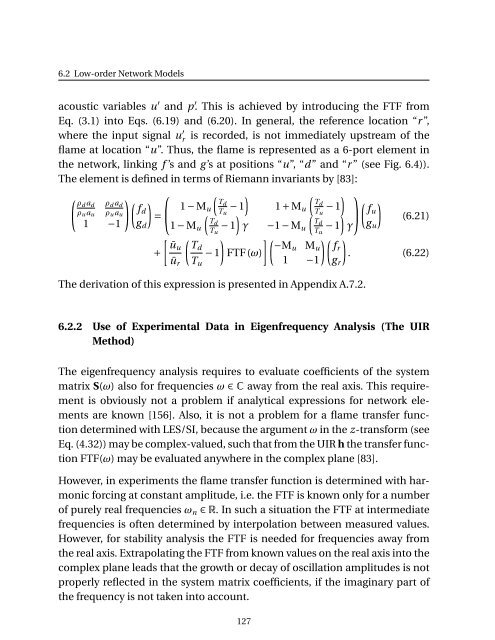Numerical Simulation of the Dynamics of Turbulent Swirling Flames
Numerical Simulation of the Dynamics of Turbulent Swirling Flames
Numerical Simulation of the Dynamics of Turbulent Swirling Flames
You also want an ePaper? Increase the reach of your titles
YUMPU automatically turns print PDFs into web optimized ePapers that Google loves.
6.2 Low-order Network Models<br />
acoustic variables u ′ and p ′ . This is achieved by introducing <strong>the</strong> FTF from<br />
Eq. (3.1) into Eqs. (6.19) and (6.20). In general, <strong>the</strong> reference location “r ”,<br />
where <strong>the</strong> input signal u r<br />
′ is recorded, is not immediately upstream <strong>of</strong> <strong>the</strong><br />
flame at location “u”. Thus, <strong>the</strong> flame is represented as a 6-port element in<br />
<strong>the</strong> network, linking f ’s and g ’s at positions “u”, “d” and “r ” (see Fig. 6.4)).<br />
The element is defined in terms <strong>of</strong> Riemann invariants by [83]:<br />
( ρd<br />
) ⎛ ( )<br />
( ) ⎞<br />
a d ρ d a d ( )<br />
ρ u a u ρ u a fd u<br />
= ⎝<br />
1 − M Td<br />
Td<br />
)<br />
u T u<br />
− 1 1 + M u T u<br />
− 1<br />
( )<br />
( ) ⎠(<br />
fu<br />
1 −1 g Td<br />
Td<br />
(6.21)<br />
d 1 − M u T u<br />
− 1 γ −1 − M u T u<br />
− 1 γ g u<br />
( ) ]( )( )<br />
[ūu Td<br />
−Mu M u fr<br />
+ − 1 FTF(ω)<br />
. (6.22)<br />
ū r T u 1 −1 g r<br />
The derivation <strong>of</strong> this expression is presented in Appendix A.7.2.<br />
6.2.2 Use <strong>of</strong> Experimental Data in Eigenfrequency Analysis (The UIR<br />
Method)<br />
The eigenfrequency analysis requires to evaluate coefficients <strong>of</strong> <strong>the</strong> system<br />
matrix S(ω) also for frequencies ω ∈ C away from <strong>the</strong> real axis. This requirement<br />
is obviously not a problem if analytical expressions for network elements<br />
are known [156]. Also, it is not a problem for a flame transfer function<br />
determined with LES/SI, because <strong>the</strong> argument ω in <strong>the</strong> z-transform (see<br />
Eq. (4.32)) may be complex-valued, such that from <strong>the</strong> UIR h <strong>the</strong> transfer function<br />
FTF(ω) may be evaluated anywhere in <strong>the</strong> complex plane [83].<br />
However, in experiments <strong>the</strong> flame transfer function is determined with harmonic<br />
forcing at constant amplitude, i.e. <strong>the</strong> FTF is known only for a number<br />
<strong>of</strong> purely real frequencies ω n ∈ R. In such a situation <strong>the</strong> FTF at intermediate<br />
frequencies is <strong>of</strong>ten determined by interpolation between measured values.<br />
However, for stability analysis <strong>the</strong> FTF is needed for frequencies away from<br />
<strong>the</strong> real axis. Extrapolating <strong>the</strong> FTF from known values on <strong>the</strong> real axis into <strong>the</strong><br />
complex plane leads that <strong>the</strong> growth or decay <strong>of</strong> oscillation amplitudes is not<br />
properly reflected in <strong>the</strong> system matrix coefficients, if <strong>the</strong> imaginary part <strong>of</strong><br />
<strong>the</strong> frequency is not taken into account.<br />
127
















